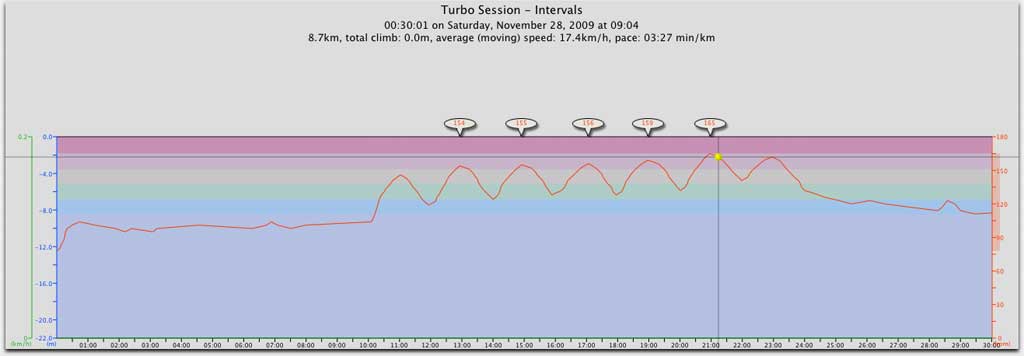Turbo Trainer Workouts – Measuring your Progress
One of the nice things about using a Turbo Trainer for cycling training is that your workouts are repeatable without issues such as the weather / terrain making too much difference to your performance. This means that it is a useful tool for tracking your progress as you can repeat a workout exactly and see how you compare to previous workouts.
One test for such comparisons is the PWC test which compares power output to heart rate. There are various ways of doing this, some more complicated than others. The idea is to find your power output at 170bpm.
Performing the Test
Performing the tests are easy. After a warm up you simply need to do two consecutive 6 minute workouts in which the workloads are selected to produce a steady heart rate between 120 and 140 bpm on the first session and 150 and 170 bpm on the second session.
This obviously takes a bit of guesswork to start with in order to get the workloads right, but the idea is to achieve a steady heart rate within those ranges by the end of each ride.
For each session, the Heart Rate (bpm) and Power Output (watts) are recorded.
Calculating your Results
You can either plot your results on a graph with power output on one axis and heart rate on the other. Join the two points with a straight line and extend the line out to 170bpm to find your Power output at 170bpm, or use the following equation:

Where:
- P1 = Power (watts) for session 1
- P2 = Power (watts) for session 2
- HR1 = Heart rate for session 1
- HR2 = Heart rate for session 2
Don’t worry about doing it yourself though, use the form below to calculate your PWC results:
Repeating this test regularly allows you to track the progress of your power output.
My PWC170 Results
I tried the test today and my results were as follows.
- Heart Rate 1: 122 bpm
- Heart Rate 2: 152 bpm
- Power 2: 260 Watts
Power 1: 180 Watts
This gives me a PWC170 result of 308 Watts.
The advantages of this test are that it is quick and easy to perform. If you have an Ergo-trainer, a heart rate monitor and half an hour to spare you can do it. You don’t have to have a helper to note down lots of figures and it isn’t too strenuous either. It may not give you meaningful results in the same way that doing VO2 Max tests and such like will, but it does allow for comparisons to be made so that you can chart your progress.















That sounds like a good test Al. Easy to do and it doesn’t sound as though you need to go until you collapse like you do with lots of other fitness test.
Do you think you could use the results for anything other than a benchmark?
Mark.
Hi Mark,
In theory it should give you an approximation to the power output you can produce at around 85-95% of your workload. This will depend on your age as the 170bpm is a theoretical 85% mark for a 20 year old.
For someone aged 40 170bpm is closer to 95% of their maximum.
I guess these figures could be used to give you an idea of the power output you should be aiming for when doing interval training.
I just like to see if I can better myself now and then.
Al.
Did it again today without having to ramp up to the correct workloads. Although I think I need to increase them slightly.
Today’s Score was 318.
https://www.alananna.co.uk/blog/2010/pwc170-test/
Increased the wattages quite a bit on my PWC170 test today in order to get my heart rate within the suggested ranges.
First 6 minutes was at 200 Watts with a heart rate of 118bpm.
Second 6 minutes was at 280 Watts with a heart rate of 150bpm.
Meaning the result I got today was 330.
Quite pleased with that.
Al.